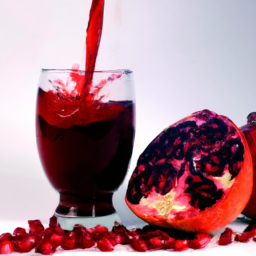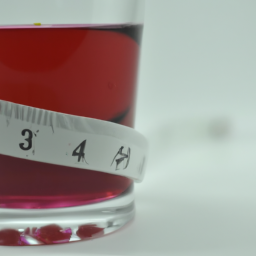As someone who values health and is always seeking ways to improve my diet, I have been hearing a lot about the benefits of pomegranate juice. However, as I delved deeper into the topic, I realized that I had little knowledge about the price of this trendy drink. This inspired me to do some research to figure out the cost of pomegranate juice and learn about the factors that affect its price.
In this article, I’ll be sharing what I learned about the cost of pomegranate juice, including factors that affect pricing, comparisons of different brands, and tips for finding deals. I’ll also dive into the differences between organic and non-organic options, as well as cold-pressed vs. regular juice.
Whether you’re a fan of pomegranate juice already or just curious about trying it out, this guide will help you make an informed decision about the value of this popular drink.
Key Takeaways
- The cost of pomegranate juice is affected by factors such as brand, packaging, concentration, and location.
- Popular brands of pomegranate juice include POM Wonderful, Tropicana, Ocean Spray, Lakewood, and Trader Joe’s, with Lakewood being the most expensive and Trader Joe’s offering the best deal.
- Organic options may be more expensive but are free from harmful pesticides and chemicals and may contain higher nutrient levels.
- Local availability and importing costs can greatly impact the price of pomegranate juice, and it’s important to compare prices before making a purchase.
Understanding the Health Benefits of Pomegranate Juice
You’re going to love the health benefits you get from drinking pomegranate juice! Not only does it taste delicious, but it also has numerous benefits for your body.
One of the most significant benefits of pomegranate juice is its ability to promote heart health. Studies have shown that regular consumption of pomegranate juice can lower blood pressure, reduce inflammation, and improve cholesterol levels.
In addition to promoting heart health, pomegranate juice can also boost your immune system. It contains antioxidants that help fight off harmful free radicals in your body. These free radicals can damage your cells and increase the risk of developing chronic diseases. By drinking pomegranate juice regularly, you can give your immune system a much-needed boost and protect your body from these harmful effects.
Now, let’s talk about factors that affect the cost of pomegranate juice.
Factors that Affect the Cost of Pomegranate Juice
When I’m shopping for pomegranate juice, I’ve noticed that the prices can vary quite a bit. After doing some research, I’ve learned that there are several factors that can affect the cost of pomegranate juice.
These factors include the brand, packaging, concentration, and location of where the juice is produced.
Brand
The price of pomegranate juice can vary depending on the brand, with some of the top-selling brands costing around $4 per 16-ounce bottle. When it comes to buying pomegranate juice, brand name is an important factor to consider. Here are some things to keep in mind:
- Some brands use organic pomegranates, which can increase the price.
- Certain brands may only be available in certain regions, affecting their price and availability distribution.
- Some brands may offer larger or smaller bottle sizes, affecting the price per ounce.
- Premium brands may charge a higher price due to their reputation and marketing strategies.
- Store brand or generic options may offer a lower price point for consumers on a budget.
Considering these factors, it’s important to do your research and compare prices before making a purchase.
Next, we’ll explore another important factor in the cost of pomegranate juice: packaging.
Packaging
If you want to experience the luxurious sensation of drinking from a glass bottle, opt for brands that offer this type of packaging. While plastic bottles are more common and affordable, glass bottles are more sustainable and preferred by consumers who value the overall drinking experience. Not only are glass bottles reusable and recyclable, they also preserve the flavor and quality of the juice. Some popular brands that offer pomegranate juice in glass bottles include POM Wonderful, Lakewood, and R.W. Knudsen.
In addition to glass bottles, some brands also offer other sustainable packaging options such as cartons or pouches. These types of packaging are also preferred by consumers who are conscious about reducing their environmental impact. However, it is important to note that the packaging type may affect the price of the juice. For example, pomegranate juice in glass bottles may be more expensive than the same juice in plastic bottles or cartons. Ultimately, the choice of packaging depends on the consumer’s preferences and priorities.
Moving on to the next section, the concentration of pomegranate juice is another factor that affects its price.
Concentration
Opting for a higher concentration of pomegranate juice can lead to a more intense flavor and a higher price tag. However, it’s important to note that higher concentration does not necessarily mean better juice quality. The recommended dosage for pomegranate juice is approximately 8 ounces per day, which can easily be achieved with a lower concentration juice.
When it comes to concentration, it’s all about personal preference. Some people prefer a stronger flavor and are willing to pay more for it, while others may prefer a milder taste. Keep in mind that the price of pomegranate juice can vary greatly depending on the concentration, with higher concentration juices costing significantly more.
In the end, it’s important to find the concentration that works best for you and your budget. Transitioning into the subsequent section about location, it’s worth noting that the price of pomegranate juice can also vary depending on where you purchase it.
Location
In addition to concentration, another important factor in determining the cost of pomegranate juice is location. Local availability can greatly impact the price of the juice, as importing the fruit from other regions can incur high costs.
For example, if you live in a region where pomegranates are grown and harvested, you may be able to find locally produced juice at a lower cost than if you live in a region where pomegranates are not readily available. On the other hand, if you live in a region where pomegranates are not grown, the juice may have to be imported from another location, resulting in higher costs due to transportation and import fees.
When it comes to comparing prices of different brands of pomegranate juice, it’s important to keep both concentration and location in mind.
Comparing Prices of Different Brands
Wow, you won’t believe the outrageous prices some brands are charging for pomegranate juice! I recently did some research and found that there is quite a difference in pricing among various brands and retailers. I decided to compare the prices of five popular brands of pomegranate juice: POM Wonderful, Tropicana, Ocean Spray, Lakewood, and Trader Joe’s.
Here is a table showing the prices of each brand at three different retailers:
| Brand | Target | Walmart | Whole Foods |
|---|---|---|---|
| POM Wonderful | $4.99 for 16 oz | $4.98 for 16 oz | $4.99 for 16 oz |
| Tropicana | $3.79 for 12 oz | $3.79 for 12 oz | $3.99 for 12oz |
| Ocean Spray | $3.59 for 33.8 oz | $3.58 for 33.8 oz | $3.99 for 33.8 oz |
| Lakewood | $6.99 for 32 oz | $6.99 for 32 oz | $6.99 for 32 oz |
| Trader Joe’s | $3.99 for 32 oz | N/A | $3.99 for 32 oz |
As you can see, there is quite a difference in pricing among the brands. Lakewood is the most expensive, with all three retailers charging $6.99 for a 32 oz bottle. Meanwhile, Trader Joe’s has the best deal, charging only $3.99 for the same size bottle. It’s interesting to note that while Walmart doesn’t carry Trader Joe’s brand, they do carry the other four brands and charge the same prices as Target for each. This shows that pricing can vary not only among brands, but also among retailers.
Moving on to the next subtopic, let’s take a look at the difference between organic and non-organic pomegranate juice.
Organic vs. Non-Organic Pomegranate Juice
When it comes to choosing between organic and non-organic options for pomegranate juice, there are some important factors to consider. Here are three reasons why organic may be the superior choice:
- Organic juice is free from harmful pesticides and chemicals, making it better for the environment.
- Organic farming practices often prioritize soil health and biodiversity, resulting in a more sustainable agricultural system.
- Some studies suggest that organic produce may contain higher levels of certain nutrients, such as antioxidants, than their non-organic counterparts.
However, it’s important to note that organic options may come at a higher cost. While the health implications and environmental benefits may be worth it for some, others may opt for non-organic options due to budget constraints.
As we move into discussing cold-pressed vs. regular pomegranate juice, it’s worth noting that the same considerations around organic vs. non-organic apply. Regardless of the processing method, choosing an organic option may provide additional health benefits and promote sustainability.
Cold-Pressed vs. Regular Pomegranate Juice
Get ready to taste the difference between cold-pressed and regular pomegranate juice – your taste buds will thank you. Cold-pressed juice is made using a hydraulic press that extracts the juice from the fruit without applying heat. The result is a juice that is richer in nutrients and enzymes than regular juice. In fact, cold-pressed juice can contain up to 5 times more nutrients than regular juice.
Not only is cold-pressed juice more nutritious, it also tastes better. The low-heat extraction process preserves the natural flavor of the fruit, resulting in a juice that is sweeter and more refreshing than regular juice. Check out the table below to see the differences in taste between cold-pressed and regular pomegranate juice:
| TASTE | COLD-PRESSED POMEGRANATE JUICE | REGULAR POMEGRANATE JUICE |
|---|---|---|
| Sweetness | More | Less |
| Tartness | Less | More |
| Refreshment | More | Less |
Now that you know the benefits of cold-pressed pomegranate juice and the differences in taste between cold-pressed and regular juice, let’s move on to the next section about concentrated vs. non-concentrated pomegranate juice.
Concentrated vs. Non-Concentrated Pomegranate Juice
Moving on from the previous subtopic about cold-pressed and regular pomegranate juice, let’s now talk about the difference between concentrated and non-concentrated pomegranate juice. As someone who enjoys drinking pomegranate juice, I’ve often wondered about the taste and health implications of choosing one over the other.
Firstly, concentrated pomegranate juice is made by extracting most of the water content from the juice. This process results in a more intense flavor and a sweeter taste compared to non-concentrated juice. On the other hand, non-concentrated pomegranate juice is made by pressing fresh pomegranates, without any added water or sugar. While it may have a more mild taste, it also retains more of the natural nutrients found in the fruit.
When it comes to choosing between the two, it ultimately depends on personal taste preferences and health priorities. Here are some things to consider:
- Concentrated pomegranate juice may contain added sugar, which can increase the calorie count and affect blood sugar levels.
- Non-concentrated pomegranate juice may have a shorter shelf life and may need to be refrigerated to maintain freshness.
- Concentrated pomegranate juice may be more cost-effective, as it requires less fruit to make a larger quantity of juice.
- Non-concentrated pomegranate juice may offer more health benefits, as it retains more of the natural nutrients found in the fruit.
As someone who’s mindful of both taste and health, I personally prefer non-concentrated pomegranate juice for its natural flavor and nutrient content. However, it’s important to make a choice based on individual preferences and priorities. Speaking of priorities, investing in higher-quality pomegranate juice can offer even more benefits, which we’ll explore in the next section.
Benefits of Investing in Higher-Quality Pomegranate Juice
Investing in top-notch pomegranate juice can be a smart move for those seeking maximum health benefits and exceptional flavor. Higher-quality pomegranate juice typically contains more antioxidants, which are beneficial for heart health and can help reduce inflammation in the body. In addition, top brands often use fresher and riper pomegranates, resulting in a richer taste and aroma.
Moreover, investing in high-quality pomegranate juice can provide health advantages that lower-quality options may not offer. For example, some higher-end brands use organic and non-GMO pomegranates, ensuring that the juice is free from harmful chemicals and additives. Additionally, investing in top-notch pomegranate juice can be more cost-effective in the long run, as it may provide more health benefits per ounce.
With all these benefits, it’s easy to see why investing in high-quality pomegranate juice is a wise choice for those looking to improve their overall health and wellbeing.
When it comes to finding deals on pomegranate juice, there are a few helpful tips to keep in mind.
Tips for Finding Deals on Pomegranate Juice
You’ll want to keep an eye out for sales and promotions if you’re looking to save money on pomegranate juice. Finding discounts on your favorite brand can be as simple as checking your local grocery store’s weekly flyers or signing up for email alerts from juice companies.
Many retailers also offer bulk purchasing options, allowing you to save money when buying larger quantities of juice.
Another way to save money on pomegranate juice is to consider alternatives to the bottled variety. Making your own juice at home using fresh pomegranates can be a cost-effective solution, and it also allows you to control the quality and amount of sugar added.
Additionally, incorporating pomegranate seeds or juice into your meals or smoothies can provide many of the same health benefits at a lower cost.
Alternatives to Pomegranate Juice
Looking for other options besides the classic bottled drink? There are plenty of tasty alternatives to explore when it comes to pomegranate juice.
For starters, you can try making your own juice by blending fresh pomegranate seeds with water and a touch of sweetener. This allows you to control the sweetness and avoid any added preservatives or sugars found in store-bought options.
Another healthy drink option is to mix pomegranate juice with other fruit juices, such as orange or grapefruit, for a delicious and nutrient-packed beverage. You can also incorporate pomegranate juice into smoothies, chia seed puddings, or even salad dressings for a unique and flavorful twist.
With so many pomegranate juice alternatives available, there’s no shortage of ways to enjoy the benefits of this superfruit.
When it comes to the value of pomegranate juice, it’s clear that there are numerous options available for those looking to explore beyond the classic bottled drink. From DIY juice blends to incorporating it into other recipes, there are plenty of ways to enjoy the health benefits of pomegranate juice.
So, whether you’re a fan of the classic drink or looking to try something new, there’s no denying the power of this nutritious and delicious fruit.
Final Thoughts on the Value of Pomegranate Juice
Wow, can’t believe all the amazing benefits this superfruit has to offer! Incorporating pomegranate juice into your diet is a no-brainer if you want to feel your best!
From reducing inflammation to improving heart health, this juice has a lot to offer. Here are three reasons why pomegranate juice is worth the cost:
-
Consumer satisfaction: Many people who regularly drink pomegranate juice rave about the taste and the way it makes them feel. Plus, the antioxidants and other nutrients in this juice can provide a range of health benefits.
-
Potential drawbacks: While pomegranate juice is generally considered safe for most people, there are a few potential drawbacks to keep in mind. For example, some people may experience stomach upset or diarrhea if they drink too much of it.
-
Overall value: When you consider the many benefits of pomegranate juice, it’s clear that the cost is worth it. Whether you’re looking to improve your heart health, reduce inflammation, or just enjoy a delicious and healthy drink, pomegranate juice is an excellent choice.
So why not give it a try today and see for yourself?
Frequently Asked Questions
What are the different ways to consume pomegranate juice?
When it comes to consuming pomegranate juice, there are various options available. One can opt for juice blends or prepare DIY recipes at home. These options offer a refreshing and healthy way to incorporate pomegranate into one’s diet.
Can pomegranate juice be harmful or have any negative side effects?
As with any food or drink, there are potential health risks associated with consuming pomegranate juice. These include interactions with medications and possible allergic reactions. It’s important to speak with a healthcare provider before consuming pomegranate juice regularly.
Is there a recommended amount of pomegranate juice to consume daily?
Although the benefits of pomegranate juice are promising, it’s important to note that there can be drawbacks as well. As for recommended daily intake, it varies depending on age, gender, and overall health status.
What is the shelf life of pomegranate juice?
Pomegranate juice can last up to five days in the refrigerator once opened. It’s important to check for spoilage before consuming. As for daily consumption, experts recommend one cup per day for potential health benefits.
How can I tell if the pomegranate juice I am purchasing is fresh?
Choosing fresh pomegranate juice is crucial for maximum health benefits. Check for the expiration date and choose glass bottles over plastic. Store in the fridge and consume within 3-5 days of opening for freshness.
Conclusion
In conclusion, after learning about the numerous health benefits of pomegranate juice, it’s clear that the cost is worth it. While the price of pomegranate juice may vary depending on factors such as brand, quality, and organic vs. non-organic, investing in higher-quality, cold-pressed options can provide even greater benefits.
When considering the value of pomegranate juice, it’s important to keep in mind the potential cost savings on medical bills and overall health. By incorporating pomegranate juice into a balanced diet, individuals can potentially improve their immune system, reduce inflammation, and lower their risk of chronic diseases.
As the saying goes, "an ounce of prevention is worth a pound of cure,"and investing in the benefits of pomegranate juice is a wise choice for overall health and well-being.
Ilana has been a vegan for over 10 years. She originally made the switch for health reasons, but soon found herself becoming more and more passionate about the ethical and environmental implications of a vegan lifestyle. Ilana is the author of The Graceful Kitchen, a blog all about veganism. She loves to cook up delicious and nutritious vegan meals, and share her recipes with others who are interested in leading a cruelty-free life. Ilana is also a strong advocate for using whole foods as the foundation of a healthy diet, and believes that going vegan is one of the best ways to achieve this.










